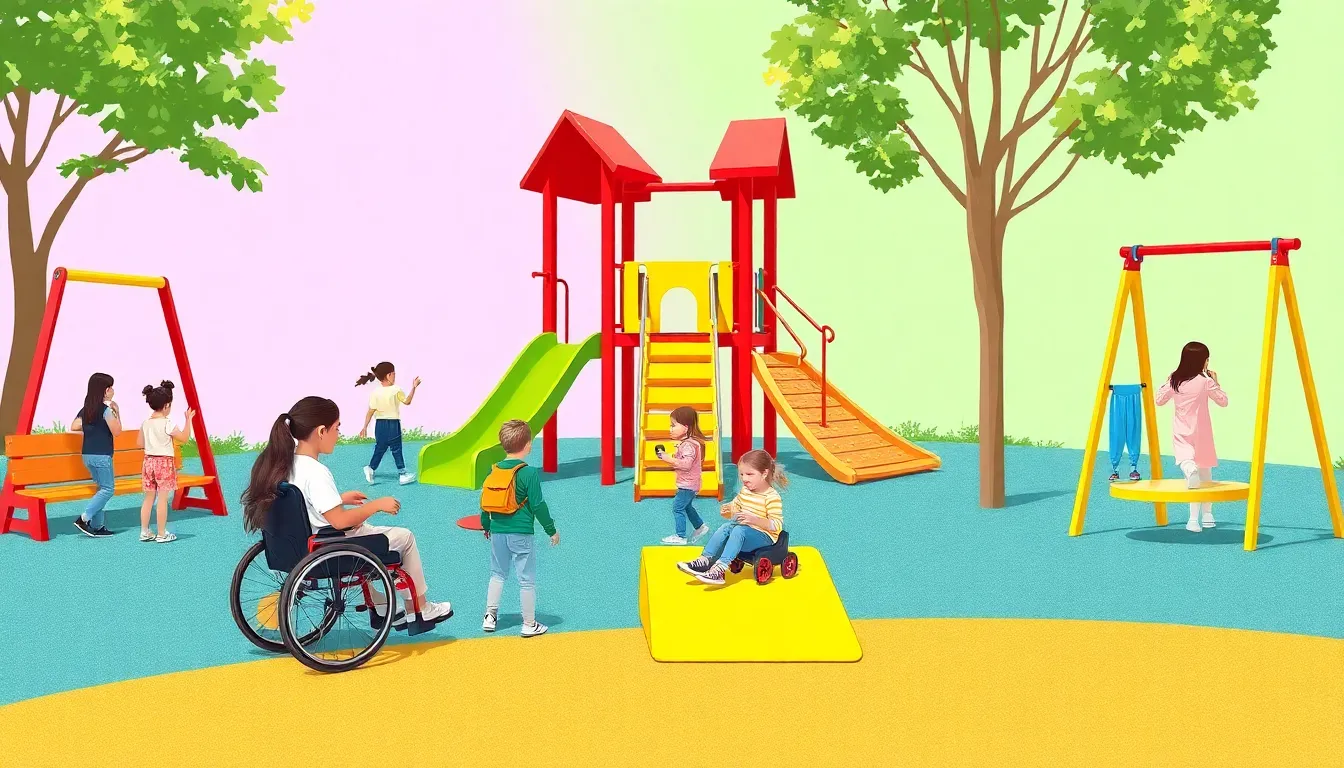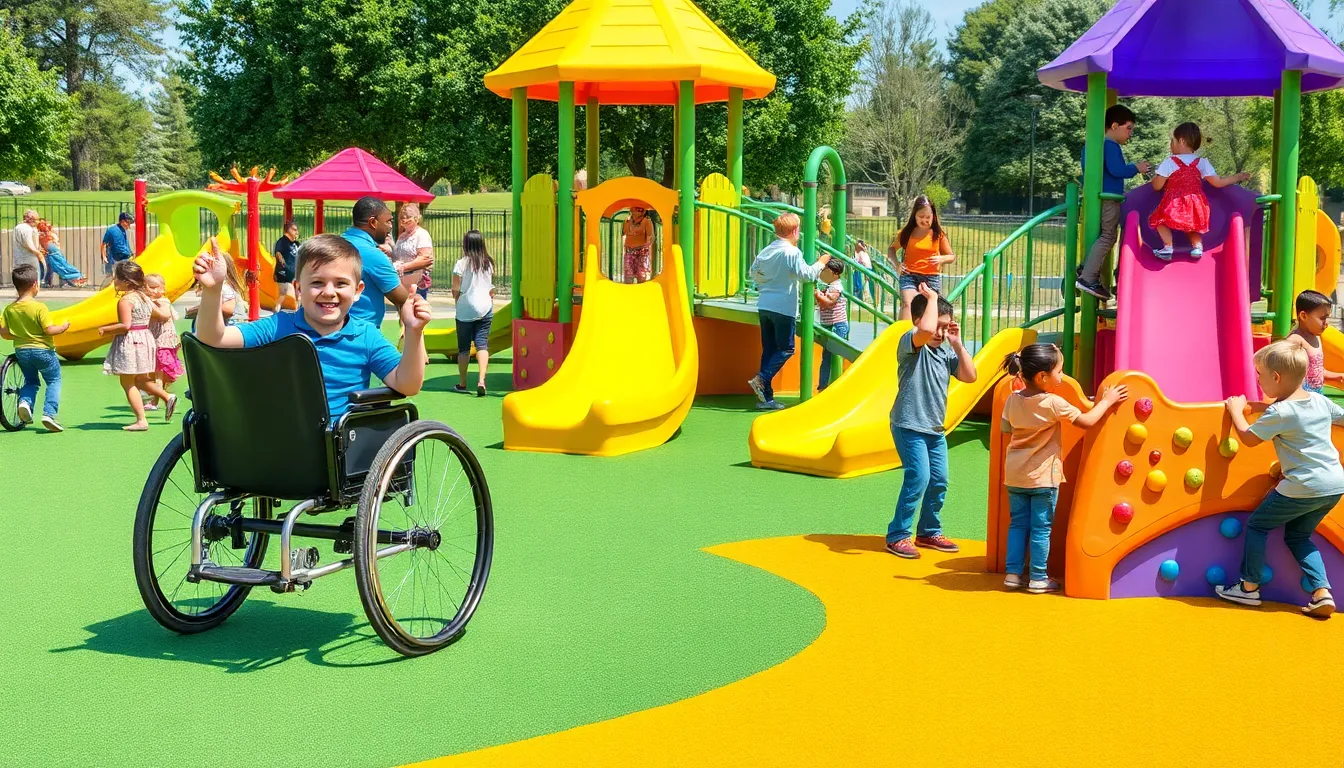Table of Contents
ToggleImagine a playground where every child can swing, slide, and climb without a care in the world. Inclusive playgrounds are transforming the way kids play, making sure no one gets left out of the fun. They’re not just about accessible swings; they’re vibrant spaces designed for everyone, regardless of ability.
The Importance of Inclusive Playgrounds
Inclusive playgrounds transform play experiences for all children, ensuring accessibility and enjoyment without barriers. These spaces foster creativity, growth, and emotional well-being, essential for every child.
Benefits for Children with Disabilities
Inclusive playgrounds provide various benefits for children with disabilities. These settings feature adaptive equipment that accommodates physical needs, allowing for participation alongside peers. Children gain confidence through engagement in activities, encouraging exploration and skill development. Additionally, these environments promote physical health through active play. Enhanced sensory experiences help children with sensory sensitivities feel comfortable and supported. Overall, inclusive playgrounds facilitate meaningful play that nurtures independence and individuality.
Social Interaction and Development
Social interaction is crucial for child development. Inclusive playgrounds create opportunities for diverse children to engage in cooperative play. Children learn to communicate and build friendships across different abilities. Playgrounds designed for inclusivity teach empathy and understanding, fostering an environment of acceptance. Positive social experiences help develop emotional intelligence and collaboration skills. As children navigate these interactions, they strengthen their ability to relate to others. Additionally, inclusive settings break down barriers, creating a strong sense of community among all participants.
Designing Inclusive Playgrounds

Designing inclusive playgrounds involves creating spaces that prioritize the needs of all children. Various elements contribute to effective design.
Key Features to Consider
Consider wide pathways that ensure easy access for children with mobility devices. Incorporate sensory areas that stimulate diverse experiences, such as textured surfaces and interactive panels. Look for shade structures that protect from sun exposure, promoting comfort during play. Equip playgrounds with quiet zones for children needing sensory breaks. Use bright colors and engaging designs that attract all children, encouraging exploration and play.
Accessible Equipment Options
Choose swings with adaptive safety seats to accommodate children of varying abilities. Install ramps for smooth transitions between different play areas. Select climbing structures that have varying difficulty levels, catering to diverse skill sets. Provide tactile play panels that enhance engagement and learning. Ensure slides are wide enough for wheelchair users, allowing everyone to participate in fun activities.
Case Studies of Successful Inclusive Playgrounds
Inclusive playgrounds have emerged as important spaces for all children. Highlighting real-world examples can illustrate their impact.
Examples from Around the Country
New York City’s “Adventure Playground” offers diverse equipment and sensory-rich areas, promoting inclusion. This playground features adaptive swings and climbing structures that accommodate children with various abilities. In California, the “Magic Bridge” playground integrates tactile experiences, encouraging exploration among children with sensory sensitivities. Florida’s “Playgrounds for All” initiative showcases several inclusive sites throughout the state, facilitating interactions and friendships among diverse groups. Communities in these regions report increased engagement from children and parents alike, fostering a shared sense of belonging.
Lessons Learned from Implementation
Successful implementation of inclusive playgrounds teaches valuable lessons. Community involvement stands out as critical for meeting children’s varied needs. Engaging local stakeholders ensures designs resonate with families, incorporating unique preferences and ideas. Balancing accessibility and play value ranks highly in importance. Feedback from parents and children enhances playground features and usability. Additionally, consistent maintenance and safety checks prove essential for sustaining inclusive play experiences. Incorporating feedback mechanisms allows for continual improvement and advocacy for future projects.
Community Involvement in Playground Development
Community involvement plays a crucial role in the successful development of inclusive playgrounds. Engaging local stakeholders ensures that the playgrounds meet diverse needs.
Engaging Families and Local Organizations
Families and local organizations contribute valuable insights during the planning process. They provide perspectives on the specific needs and preferences of children in the community. Involving these groups fosters a sense of ownership and pride in the playground. Collaborative workshops and meetings allow for open dialogue, and communities often discuss equipment features, design elements, and safety concerns. Successful projects frequently incorporate feedback from families, ultimately creating a space that truly reflects their desires.
Funding and Support for Inclusive Initiatives
Funding and support are essential for advancing inclusive playground initiatives. Grant opportunities from government agencies and private foundations provide critical financial resources. Local businesses often lend support through sponsorship or in-kind donations. Community fundraising events, such as bake sales and charity runs, engage residents and raise awareness for the cause. These initiatives typically create a sense of unity, showing that everyone can contribute to enhancing children’s play experiences. Cultivating partnerships between schools, nonprofits, and local governments further strengthens these efforts, ensuring sustained support for inclusive playground development.
Inclusive playgrounds are more than just play areas; they’re vital spaces that promote unity and growth among children of all abilities. By prioritizing accessibility and sensory experiences, these playgrounds nurture creativity and emotional well-being. They encourage social interactions that help children develop empathy and forge friendships.
Community involvement plays a crucial role in their success, ensuring that the unique needs of local families are met. With ongoing support and maintenance, inclusive playgrounds can continue to thrive, enriching the lives of children and fostering a sense of belonging. The commitment to creating these inclusive spaces paves the way for a brighter future where every child can enjoy the joy of play together.






